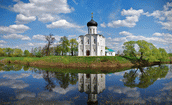| |
Russian Revolution's Forum
E-books World history, Rus' history and Religions history
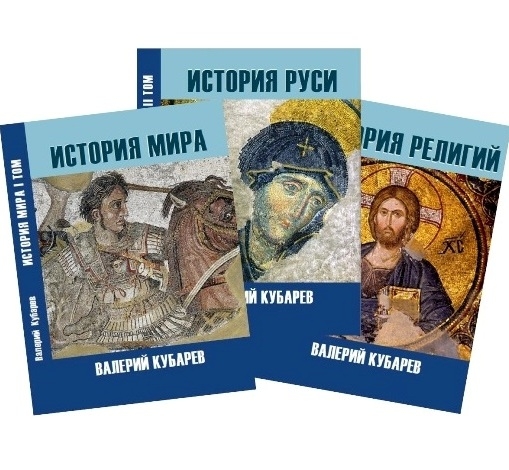
Modernization of Russia
Holy Russia - Third Rome
The new subject of international law, the State Holy Russia - Third Rome, 21.09.2013. | Nova Church of Holy Russia
Orthodoxy and Christianity require reforming and release of heresy and obscurantism. 21.09.2011. | Ethnopolitical transformation of Russia New!!!
The author investigates the deep ethnic and political processes occurring within Russian society. Russian statehood and the people are at a historical crossroads. The path chosen by the authorities leads to a dead end of a renewed Kyrgyz Khaganate. The alternative will allow the Russian people to achieve a European renaissance and rid themselves of barbarism and savagery. 08/26-09/06/2025. | The Seljuk Dynasty Origin New!!!
The author put forward a hypothesis according to which the Seljuk’s Sultans came from the Princes of the Russ – Rurikovich Kin, who eventually converted to Islam. The hypothesis was fully confirmed by the identification of the main historical figures of the Seljuk dynasty with the descendants of the Princes St. Vladimir and Yaroslav the Wise. We are talking about the rulers of Sultanate of Rum Sultan Suleiman and his descendants, as well as Tuqaq, Seljuk, Mikail, Israel, Toghrul, Alp Arslan and other Sultans. Princes and their sons from the Principality of Tmutarakan became Seljuk’s Sultans, from where they conquered the countries and peoples of the Caucasus, Iran, Asia Minor and Central Asia. 24.05–12.06.2023. | Synchronization of historical and religious Chronicles
The author correctly synchronizes historical and religious Chronicles of the Ancient World based on a short chronology and linking events to unique celestial phenomena reflected in the annals and Scriptures. The author believes that discrepancies in dates, geographical localities and ethnic origin of historical and religious figures are due to erroneous traditional chronology and historical geography, as well as the deliberate adaptation of phenomena and events to an established paradigm. 20.04–25.05.2020. | Astronomical dating of Biblical events
The author's reconstruction of the history and chronology of religions is fully verified by identifying 15 celestial phenomena described in the Chronicles, including 11 Solar Eclipses, 3 Zodiacs and 1 Supernova. A chronological shift of 1780 years in the history of Ancient Egypt has been confirmed for 6 phenomena, including 3 Solar Eclipses and 3 Zodiacs, including the Eclipse of Pharaoh Takelot on August 8, 891. Astronomically confirmed the date of the Crucifixion of Jesus Christ as March 18, 1010, and the date of death of Ibrahim – the son of the Prophet Muhammad as February 7, 1152 (28 Shawwal 546 AH). 20.02–31.03.2020. | Origin of the gens Rurik
After the break of ties between the metropolis and the Russian principalities, the annals of Byzantium were cleared of the mention of "foreigners" in the management of the Empire, and the Chronicles of Russia did not have time to properly reflect the role of Rurik in world history. A study of the sources of Ancient Rome, New Rome, Russia, Arab countries, Danube and Volga Bulgaria allowed the author to identify the Russ gens and Bulgarian Khagans with the Flavian dynasty, as well as to identify Rurik, his descendants and relatives from the Macedonian dynasty (IX–XI century) and dynasty of Lecapenus (X century). The last Russian Emperor of New Rome been Yaroslav the Wise, throne name Constantine Monomachos. 11.09–21.10.2019. | Chronology of monotheistic religions
The author identified the Patriarchs of monotheism with well-known figures of human history. He proved that the oldest religion of monotheism is Christianity, which had a theoretical character in the I Millennium (Old Testament Christianity) and a practical embodiment at the beginning of the II Millennium (New Testament Christianity). Islam and Judaism emerged only in the early VII century and became radical branches of Christianity. Based on the study of solar eclipses, the author has determined the date and place of the Crucifixion of Jesus Christ (March 18, 1010 in Constantinople), the year of the death of the Prophet Muhammad (1152) and the period creation of the Quran (1130–1152). 01–27.08.2019. | Localization of Ancient Rome
The history of Ancient Rome is well studied, but hides a lot of inconsistencies and contradictions relating to the period of formation of the city and the expansion of the Romans into the world. We believe that the problems are caused by ignorance of the true localization of Ancient Rome in the Volga region on Akhtuba until the Fire on 64 and move city to location of Veii in Italy. The article also considers the aspects of ethnic origin of the peoples of the Latin League, Ancient Rome and Europe. The vector of expansion of Ancient Rome from the Volga region to the Europe coinciding with the migration flows of the Migration Period and the spread of PIE is substantiated. In addition the article considers the dynamics of growth and decline of the population of Ancient Rome in the localities from its inception to sunset and transformation. 23.06–16.07.2019. | Short chronology of Ancient Egypt
The history of Ancient Egypt generated in XIX century, every day finds out all greater discrepancy to modern realities both the newest archeological and tool data, including results of DNA researches of mummies of the Egyptian pharaohs. The chronology of Egypt as whole is considered well investigated and however it has been created for substantiation of an antiquity of Jewish people, instead of for scientific description of one of most ancient terrestrial civilizations. Author's reconstruction of chronology of Ancient Egypt has found out time shift at rate 1780 years in depth of centuries from true dating events. 1-16.06.2019. | Great Tartary or Slavic Empire
The next riddle of world historiography is solved. Present clause is devoted to history and modern condition of one of the most grandiose empires of terrestrial civilization – Great Tartary or Slavic Empires. 04–19.09.2017. | The European Aryans
In present clause the broad audience of the questions connected to probable Aryan origin of various European peoples is considered. Including aspects of possible an Aryan origin of Slavs and prospects of presence by these of special way to world around are considered. 25.02.2017 - 24.03.2017. | Summarizing of Zemsky Sobor 2016 (Land Assembly 2016)
Within the framework of carrying out Zemsky Sobor 2016 (Land Assembly 2016) on elections of Grand Prince of All Russia four Nominees have been put forward. The overwhelming majority of voices have been given for Nominee Grand Prince Valeriy Viktorovich Kubarev. Will of God and decision of participants of Assembly, Zemsky Sobor 2016 has elected lifelong Grand Prince of All Russia Valeriy Viktorovich Kubarev Grand Kubensky Rurikovich. 11.05.2016. | Yaroslavl’s Princes Rurikovich
In clause is described family tree of Grand Princes of Yaroslavl and their descendants, it is the senior branch of the Kin of Russ – Rurikovich, going back to Mstislav Great Monomachos. Kin of the Grand Princes of Yaroslavl have continued by Princes Grand Kubensky – Kubarev. 22.02.2016–11.03.2016. | All truth about Saint Prince Vladimir
In clause the all truth about Saint Prince Vladimir which is ignored Orthodox and Romanov’s historians, communistic historical science and their modern adepts, fabricating myths about Russ with « good intentions » opens without denominations. The kin of Russ - Rurikovich has created Orthodoxy and the Russian statehood, Russian people began to forget about it. Glory to Russ! 07-17.07.2015. | Brief chronology of religions
The report at XXX International conference on problems of the Civilization, 25.04.2015, Moscow, RosNoU. In the clause the final Chronological Tables of Ancient Egypt, Ancient and New Rome, Rome in Italy, Christianity, Islam and Judaism are submitted. 25.04.2015. | Canons of Orthodoxy of XIV century and the present time
The report at XXIX International conference on problems of the Civilization, 20.12.2014, Moscow, RosNoU. In the report the comparative analysis of canons of Orthodoxy of XIV century (1315-1321), displayed on mosaics and frescos of Church of Chorus in Istanbul, and modern doctrines are made. Numerous differences of events of the Holy Legend and the Gospel of the past and the present are found out. 20.12.2014. | Ethnic threats to peoples of Russia
In clause political, economic, cultural and religious aspects of consequences of ethnic opposition of radical peoples of Russia and new coming Slavic population formed as result of violent Slavic expansion in Russia in days of the Mongolian yoke are considered. The historical reasons of occurrence of ethnic contradictions are investigated, estimations of modern condition of problem (Chechelevskaya and Lubotinskaya Republics in 1905, Donetsk national republic and Lugansk national republic in 2014 in territory of Ukraine) are given and offers on decrease in escalation of ethnic opposition in territory of Eurasia are made. 09.06 - 05.07.2014. | Attribution of Rurikovich and Emperors Lecapenus
The report at XXVIII International Conference on problems of the Civilization is 26.04.2014, Moscow, RosNoU. In clause it is described detailed attribution of Ugrian Tsars with Emperors of Ancient and New Rome and Patriarches of terrestrial civilization. It is scientifically proved origins of all patriarches of monotheism and Emperors Flavius and Lecapenus from kint of Ugrian Tsars of Russ (Great), is the ethnic Finn-Ugrian from Volga region. 23.03.2014 – 24.04.2014. | Putin's Eurasian impasse
Vladimir Putin and Uniform Russia realize the Eurasian project, involving Russia and Russian people during stagnation and backlogs from World Civilization. They create Gog and Magog Empire, menacing to world peace. Why the Kremlin authority has not asked Russian Slavs – they want to live in the Asian country or to be safe Europeans? 14-22.01.2014. | Projections of the God in symbols of religion
As result of studying the extensive visual material created by 3D modeling, we have proved existence of uniform source of an origin of Projections of the God, that is religious symbolic of people. The source or quantum object refers to the Chariot of the God. We believe that on the basis of our researches, it will be possible to organize training to travel on the Universe of space navigators from the most gifted people and to create spaceships with engines as the described quantum generator is Chariots of the God or the Chariot of Cube. 25–30.08.2013. | Origin and migration of Slavs
Historical and genetic routes of migrations of the Slavs, calculated with the help from ancient Byzantium, European, Chinese, Arabian, Bulgarian and Russian chronicles and annals, and also modern researches of man's DNA chromosomes. 01-21.05.2013. | Empires of cousins of Russ
The report at scientific XXVI International conference on problems of the Civilization 26-27.04.2013, Moscow, RosNoU. In article five world Empires of cousins of Russ (Great) existing in our era on open spaces of Eurasia with cyclicity of occurrence once in 300 years are described. | Hungarian Kingdom of Russ
It is continuation of research of dynastic communications of Rurikovich. Cousin of Rurik Almysh/Almos and his children Kazan/Kurszan and Arbat/Arpad, it is all ethnic Ugrian of Russ, have based at the end of IX century – beginning of X century the Hungarian kingdom of Russ, having grasped Great Moravia. 08-11.01.2013. | Reconstruction of dynastic communications of Rurikovich in IX-XI centuries
Report at anniversary scientific XXV International conference on problems of civilization at 21-22.12.2012, RosNoU, Moscow. Corrected at 03.01.2013. | Educated Christianity of Russ
Bible – the Old Testament and the New Testament has exhausted itself. Forged the Scripts and the Sacred Legend cannot serve more as a spiritual reference point for promotion of mankind forward on the river of time. It is allowable to use only spiritual – moral potential of the ancient products being product of national creativity of Jews and Catholics, instead of divine revelations. The chronology of Bible events, an ethnic accessory of patriarchs of mankind, names, geography and original languages of heroes of the Bible do not correspond to the validity. Bible miracles have the quantum nature in the basis and submit to laws of a universe. Educated Christianity of Russ restore the religious both destroyed obscurantists religious and scientific knowledge of Christianity and revolutionary role of religion in history of civilization. 26.08. – 12.10.2012. | True Empty Tomb
Nova Church of Sacred Russia and Sacred Russ, Princes of Russia congratulates mankind on presence of True Empty Tomb and restoration of the religious and historical truth. The true has triumphed forever. 20-29.05.2012. | Orthodoxy and Islam in Old Russia
The report at XXIV International scientific conference on problems of the Civilization in Russian New University on April 20-21, 2012. | Day of Church Slavonic writing. Russ Cyril and Methodius.
In this significant holiday of Day of Church Slavonic writing and remembering Equal Apostles Sacred Cyril and Methodius, Princes of Russ convincingly ask Russian Orthodox Church and the public of the orthodox countries to return to sources and correctly to name the writing, language and church books Russian, but not Slavic. Ancient Russia was the Finno-Ugric state created by Russ Christians Rurik and Igor, Cyril and Methodius, Askold and Dir, Prophetic Oleg and Sacred Olga, Sacred Vladimir and Empress Anna Macedonian.
24.05.2011. | Wars of Russ in IX-XI centuries
In article on a rich actual material it is shown, that all wars of Russ with Byzantium in 836-1043 have been connected to deduction of a throne of empire by Russian party of Constantinople headed by the Macedonian dynasty of Russ. To the author it is proved, that two centuries co-emperors of New Rome were Great Princes Rurikovich. Last Russian emperor Jaroslav Mudry known in Tsar Grad as Constantine Monomakh was. The report at scientific XXII International conference on problems of the Civilization 22-23.04.2011, Moscow, RosNoU. | Genetic distances between cousins Rurikovich
The report at scientific XXII International Conference on problems of the Civilization, on April 22-23, 2011, RosNoU, Moscow, Russia. 24.04.2011. | Slavic-Mongolian invasion to Russia
Results of our research of an origin of Slavs have not simply scientific, but political value. In view of the received data it is necessary to form the weighed policy of interethnic and inter religious attitudes in Russia and the world. The modern hobby of Russian Slavs Rodoverie, the Aries origin and the contemptuous attitude to inhabitants of Central Asia, Caucasus, Mongolia, China and other regions of the world bears a system and logic mistake. Rodoverie in general it is senseless, in fact ancestors Rodoverian in Russia and Ukraine have left Central Asia and were Kirghiz, Altaian’s, Tajik’s, Pashtun’s, Uyghur’s and Juan-Juan, and completely not blond demigods. 12-18.03.2011. | Old Rome and Italic union of the Volga region
The scientific article on an extensive historical material proves that Ancient Rome has been created by Finno-Ugric tribe’s of Italic union of the Volga region (Idel, Bulgar). Italic peoples Vestini (Vesi), Marsi (Merya), Lucani (Lucane), Marrucini (Marri) and others till now live on Volga. Finno-Ugric named Latinas (Latinyanami) German peoples of the Volga region, differently Altyn-ami that means Gold literally. Fortress Alba Longo was called Altynbash, and Volga region Rome – Ulak-Urum. Southwest capital of Finno-Ugric of Idel was city Phanagoria or the Finn–Ugoria, being in antiquities capital Bosporus Empire and Great Bulgaria was. The web of lies of the western falsifiers of history how many would not be twisted, but to it all the same there comes the end. 10-21.02.2011. | Correct genographic
We have proved fidelity Bulgarian theory of an origin of mankind. She proves to be true a natural vector of moving of people on a planet from the Volga region in all parties of Eurasia, and there from to Africa, Australia and America. All peoples and races of the world have taken place from Hindi-European, namely – from ethnic Finno-Ugric. 01-07.02.2011. | Correct DNA-Genealogy and glottochronology
Scientific article of Grand Prince Valeriy Kubarev on DNA-Genealogy and glottochronology is submitted to your attention. The author has created formulas with which help it is possible to define precisely time of life of the general ancestor and an epoch of formation of various languages. These formulas have received the name of Kubarev’s formula. With the help of mathematical calculations, Valeriy Kubarev has proved fidelity Barrow of Hypothesis of Maria Gimbutas and own reconstruction of a history of the world. We hope that results of research will find wide application in DNA-Genealogy and glottochronology. 04-14.01.2011. | Genealogy and genetics of Princes of Russia
The report of Grand Prince Valeriy Kubarev at XXI International Conference on problems of the Civilization 25.12.2010. Valeriy Kubarev's scientific article describes genetics of Rurikovich and Sorts of Russia. Grand Prince has scientifically defined modal haplotype of Rurik, Gedimin, Russ Aydar, Kubrat, Flavius and has theoretically described modal haplotype of Alexander Great, Jesus Christ Zlatoust, Prophet Mohammed and Genghis Khan. All these well-known people ethnically Finno-Ugrian from the Sort of Russ. 25.12.2010. | What do we celebrate on November 4? Loss of the national sovereignty...
National voting or voting of national representatives is unacceptable for elections of Tsar and Grand Duke, in fact tsar from the God, and the voice of people is not a voice Divine. Elections of Grand Duke only voting of Princes – patrimonial aristocracy of Russia are possible. 08-21.11.2010. | Turn of the Earth promptly comes nearer
This is article with the analysis of abnormal geophysical and climatic activity on a planet. 09-12.09.2010. | Baltavar – a symbol of Christianity, an Islam and Judaism
Petrarca: « When people will address to the history, his greatness come to live »
30-31.03.2010 | History of Russ about 3506 BC till 2012
Kubarev V.V.'s report, History of Russ about 3506 BC till 2012.
Section «Civilization aspects of the Russian history and chronology».
Tenth International scientific conference «Civilization of knowledge: global crisis and an innovative choice of Russia», Moscow, April 24-25, 2009, RosNOU. | Archive 2006-2018 |
Whose fault is it?
The Catechon Paradigm as an instrument of the Antichrist New!!!
In the article, the author examines the current state of the catechon paradigm and the practice of using the provisions of the concept in the political and public life of the Russian Federation. According to the author, the idea of the catechon in Russia was intercepted by the forces of evil and used as a screen to cover their deeds. Today, the catechon paradigm has become an instrument of the Antichrist and his adherents to gain world domination. The only resource for Lucifer’s conquest of the world is sinful people whom he can attract under his banners. As successful as his deception and seduction will be, so strong and numerous will be the army of Satan. 05–17.12.2022. | Impairment of Orthodoxy New!!!
In the article, the author has carried out a retrospective analysis of the events and processes that led to the impairment and transformation of the canons of Orthodoxy and the patristic tradition of Russian Christianity. Prohibitions and reliance on the good intentions of opportunists within the body of the church led to a natural distortion of the teaching. As a result, the Orthodox Church became vulnerable to the pressure of Lucifer's lies and deception and ceased to be a source of life. 30.09–25.11.2022. | Features of Christianity in Cappadocia New!!!
The usual facts for Cappadocia were the proximity of male and female Monasteries and their communication. The plots and frescoes of the Churches were created no earlier than the first quarter of the XI century. The isomorphic images of St. George, Theodore Stratelates and Theodore Tiron have come down to us. According to the author, St. George became a collective image of the Saints Constantine the Great and the two Theodores. The fresco of the Serpent Church depicts Onuphrius the Great as a hermaphrodite, which the Church is trying to forget. On the face of the purposeful distortion by Christianity of the Holy Tradition, led by the Holy Spirit, and the removal from the original sources. 05–28.08.2022. | Emperors Lekapenos(920–945)
Based on a thorough analysis of the chronicles of New Rome, Ancient Russia, Great Bulgaria and Arab sources, the author has justified the Finno–Ugric origin of the Macedonian Dynasty and the Lekapenos Dynasty. The details of the biographies, names, dates of rule and family ties of dozens of Emperors, Khagans and Princes of Byzantium, Russ and Bulgar coincide with great accuracy, which makes it possible to identify all the studied personalities with real historical figures. In local chronicles, they have different or identical names, depending on the national characteristics of the nicknames of the studied persons. 07.12.2020–30.01.2021. | Dancing on bones (people losses of USSR in SWW)
We have found out the facts of direct falsification of human losses of military men and civil persons of the USSR within the Second World War in some millions person. Forgery is caused by activity of the propaganda machine of the USSR and false understanding of patriotism in modern Russia. By our calculations true irrevocable losses of the population of the USSR within the SWW make 7.6–8.7 million persons from among military men and the general losses with civil people 12.8–13.9 million persons. Have run away from Stalin paradise of USSR is hundred thousand (up to 1.3 million) the persons. We believe that the name of each victim of war should be taken into account and sounded publicly. 04–18.05.2019. | Expansion of Rome from Volga region
The report at XXXIII International conference on problems of the Civilization, 24.12.2016, Moscow, RosNoU. In the report the extensive information on resettlement of peoples to Europe through ports of Bosporan Kingdom and Bosporus to the Mediterranean from the Volga region, Siberia and Caucasus during existence of Ancient Rome in delta of the rivers Volga and Akhtuba since VI century B.C. up to middle of VI century is submitted. 24.12.2016. | Seleucus and tribal leaders of Rome
The report at scientific XXXI International Conference on problems of the Civilization has acted on December 26, 2015, RosNoU, Moscow, Russia. In the report the hypothesis that "Macedonian" gains of IV century B.C. actually are the first wave of expansion of Ancient Rome and resettlement of peoples on South, East and West from territory of the Volga region and Caucasus is put forward and proved. 26.12.2015. | Picturesque Gospel of Church of Chora (Kariye) in Istanbul
Research of artifacts of Church of the Christ Savior in Chora (Church of Chorus, XIV century, Istanbul) has allowed restoring overlooked nuances of ancient doctrines of Byzantium Orthodoxy. The numerous facts of distortion Holy Book and Holy Legend have been found out at formation of modern Christian canons which at all are not an inviolable reality from above, and there is product of human creativity. 15.09–08.10.2014. | Images ancient Romans from Volga in artefacts
Long millennia in Idel-Rome-Memphis-Mitsraim-Itil-Saray-Batu lived from 600 000 up to one million person. Ruins of city are grandiose pantry of a history, culture and religion. Masonic scientists diligently avoid carrying out there scale excavation. In those places prospers only black selector of treasures. How long it is possible to hide to world elite of impostors true from people? 20-22.04.2010. | Archive 2004-2018 |
What to do?
Sixth and other questions New!!!
Why doesn't the ROC want to stop the war? 14.02.2022. | Five questions to the ROC New!!!
The first question: What is the data of the Birth of Christ now?
The second question: When and where was Jesus Christ crucified?
The third question: When will the Apocalypse begin?
Fourth question: Why Tartarus and the Kingdom of The Beast located in Russia?
The fifth question: When did Vladimir Putin become the receptacle of the Beast? 24-27.01.2022. | The Prophet Muhammad and the Quran
Based on an independent analysis of artifacts, ancestral tree and astronomical phenomena related to the deeds, life and death of the Prophet Muhammad, as well as historical evidence of the first appearance and legal use of the Quran in the life of Muslims, the author drew conclusions about the integration of several historical figures of the VII and XII centuries into the personality of the Prophet Muhammad. They became Khagan Kubrat, aka Emperor Heraclius, the Arabian Prophet or Caliph of the Rashidun Caliphs and the true Prophet Muhammad, who lived in 1090–1052. The Quran was created in 1130–1152. The proposed interpretation does not undermine the canons of the faith of Islam, but establishes the truth. 11–30.11.2021. | Syncing the chronicles of Rome and Egypt
Based on a thorough analysis of details of military campaigns and astronomical phenomena from the chronicles of Ancient and New Rome, Ancient Egypt and Persian sources, the author confirmed the chronological shift in the history of Ancient Egypt by 1780 years in the past. The author also revealed the complot of historians to conceal the existence of Ancient Egypt in I millennium by masking the deeds of the Egyptian Pharaohs of the New Kingdom for the non-existent activity of the Kings of the Sasanian Empire. 06–29.03.2021. | The identification of the Patriarchs with historical figures
The author correctly identifies the Patriarchs of monotheistic religions with historical figures of the past based on the paradigm of a short chronology of the world and linking events to unique celestial phenomena reflected in Chronicles and Scriptural. The identification of the Patriarchs is based on the analysis of data from the genealogical trees of Jesus Christ from Lucas, Matthew, mosaics of the Church of Chora, the genealogical tree of the Prophet Muhammad and lists of the Kings of the Great Bulgaria. 21.07–27.08.2020. | Pure Relationship
We have found out and have proved that at everyone men are two direct lines of Pure Relationship on which in each generation of ancestors he has only one pair pure relatives – the forefather and the foremother. All other ancestors are the listed relatives. We also have proved that each woman has two direct lines of Pure Relationship on which in each generation of ancestors it has only one pair foremothers. On the basis of research we confirm De Facto firmness of the absolute law of succession is rule Lex Salica of Pure Relationship. 05.08 – 03.09.2014. | Archive 2004-2018 |
To be continued...
Thoughts aloud: Religion
Thoughts aloud: Politics
Thoughts aloud: Advice
Thoughts aloud
To be continued...
|
|
|
|
Valery KUBAREV > Modernization of Russia > Synchronization of historical and religious Chronicles
Synchronization of historical and religious Chronicles |
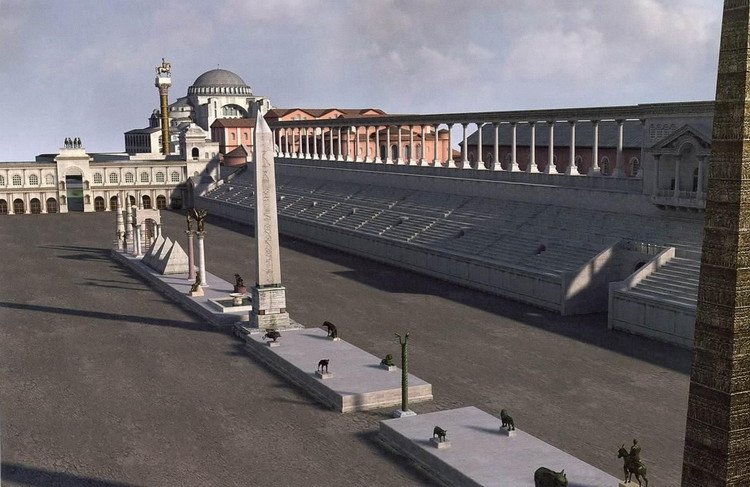
Constantinople - New Rome, Hippodrome with a view of the Hagia Sophia, X century.
Kubarev V.V., Synchronization of historical and religious Chronicles, East European Scientific Journal (Warsaw, Poland), #5 (57), 2020 part 5. pp. 21–30. Link: https://eesa-journal.com/wp-content/uploads/EESA_5_57_May_2020_part_5.pdf | Summary: The author correctly synchronizes historical and religious Chronicles of the Ancient World based on a short chronology and linking events to unique celestial phenomena reflected in the annals and Scriptures. The author believes that discrepancies in dates, geographical localities and ethnic origin of historical and religious figures are due to erroneous traditional chronology and historical geography, as well as the deliberate adaptation of phenomena and events to an established paradigm. In addition, differences in religious traditions and the facts of real history are caused by the ignorance and fanaticism of adherents of certain religions.
Keywords: Bible, Ancient Egypt, Ancient Rome, short chronology, chronicle synchronization, Solar Eclipses, Zodiacs.
Statement of problem: Modern science to the XXI century has accumulated a huge stock of documentary and archaeological data that contradict the generally accepted stereotypes of history, religion and chronology. We believe that historical clichés were created to support the fantasies of adherents of small religious doctrines. Science cannot be a bargaining chip in the hands of falsifiers and fanatics. Ignoring astronomical phenomena from Ancient Chronicles, duplicating the same events in different eras, and manipulating artifacts can no longer be acceptable from the moral and scientific point of view.
The analysis of the last of research and publications: Increasingly there are publications that refute the localization and Dating of the events of the Old Testament in modern Israel. In addition, Israeli archaeologists still can’t find artifacts older than I century. The Dating of Egyptian artifacts, the construction of pyramids and temples are questioned. Genetic studies of mummies show that the Pharaohs belong to the Germanic ethnic group Haplogroup R1b1, which baffles historians. At the same time, there are tons of articles that verbally support well-worn truths in favor of traditionalists.
Allocation unresolved before parts of the general problem: There is no exact identification of the Biblical Patriarchs with real historical figures known from the Chronicles of various States and written in different languages. There are no artifacts or structures with the names of Biblical and identical historical figures erected in honor of their deeds. There is no exact correlation between the celestial phenomena described in the Bible and the Chronicles of Ancient Egypt and real astronomical phenomena. The evidence base for existence of religious characters is reduced to following the canons of faith, not supported by scientific facts.
The purpose of clause: The purpose of this research is to substantiate the author's concept of a short chronology and synchronize Biblical events and characters with historical facts and figures from the Chronicles of Ancient Egypt, Ancient and New Rome, as well as additional connecting of the line of events through astronomical phenomena in the form of Solar Eclipses and Zodiacs at certain points in the history of the ancient world.
The basic material: In our research we adhere to the paradigm of the appearance of human civilization in the Volga region about 5500 years ago. This hypothesis was first put forward by Marija Gimbutas in 1956 [1–4]. In our research in 2009 we confirmed this theory by linking it to the canvas of historical events of the past [5], and also clarified the chronology and localization of Ancient Egypt and Rome [6, 7]. The author justified a short chronology of biblical events and monotheistic religions [8]. In addition, our conclusions are confirmed with an accuracy of several years by a cascade of astronomical phenomena in ancient Chronicles and writings [9].
The author follows the Mono centric paradigm of the emergence of modern man. Earth's civilization was formed from a single center in the Volga region, and not in many regions independently of each other. The traditional view of the appearance of man in Africa is not true, because there was born a hominid APE. About 5500 years ago, God Father formed a harem of seven female hominids that gave birth to the first 12 children – 10 boys and 2 girls. From them came the modern population of Homo sapiens sapiens through genetic mixing with existing tribes of hominids.
The history of development, expansion and dominance of Homo sapiens sapiens is connected with a single wave-like process that goes from the expanses of the Volga region, the Urals, the Caucasus and the Caspian region to the South, West and, to a lesser extent, to the East. The migration of the population was accompanied by the formation of religious paradigms and the following of religious leaders is the Patriarchs of mankind. These wise centenarians led peoples to new achievements, encouraged them to explore unknown areas, promoted the development of crafts and arts, science and technology, called for the planet to be cleansed of wild hominid tribes, etc. For these reasons, the history of mankind and the history of religions are closely intertwined with each other and are directed along the paths of human settlement on the planet, with the main vector of movement going from East to West.
The details of the existence of the first version of human civilization in the antediluvian time of Atlantis are shrouded in obscurity. We believe that Atlantis existed on the territory of the Central Russian highlands and the Caspian region. The country lay on the mainland between the Baltic Sea, the Black Sea, and the Caspian Sea, and was bounded by the Arctic and Scythian Oceans in the expanses of the modern West Siberian plain. Europe and Asia were in the southern hemisphere of the Earth, Albion and Scandinavia were covered with ice, and the Sun was rising in the West.
| 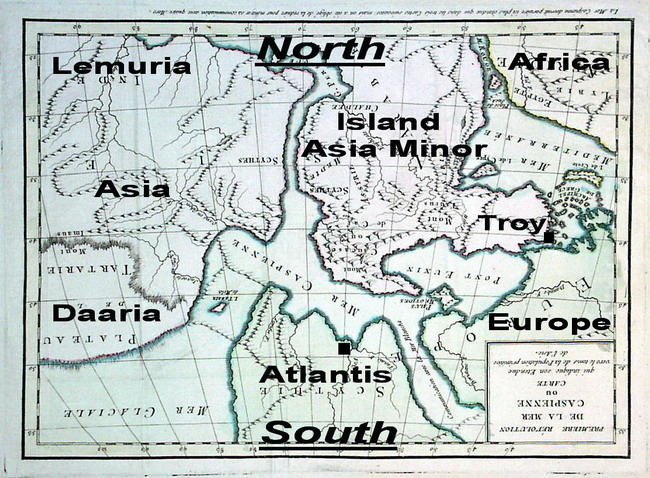
Map of the Caspian region before the Flood (top modern South, in the past North)
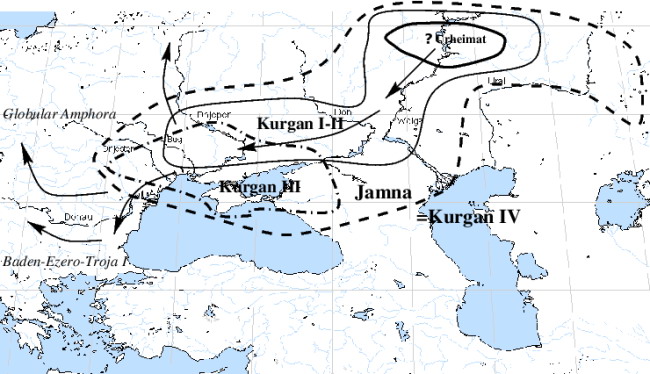
The Kurgan hypothesis of Marija Gimbutas
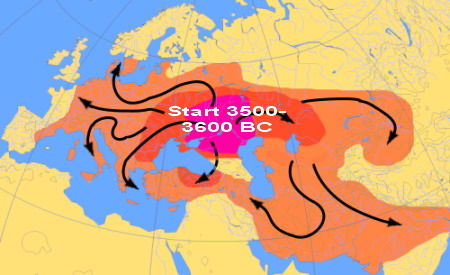
The Kurgan hypothesis of Marija Gimbutas
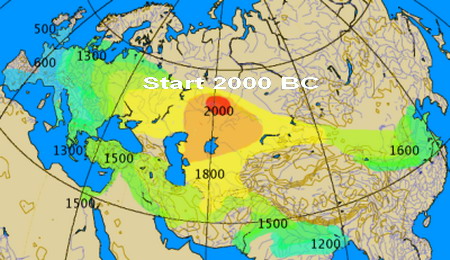
Distribution of carts and wheels around the world from the Urals, 2000 BC.
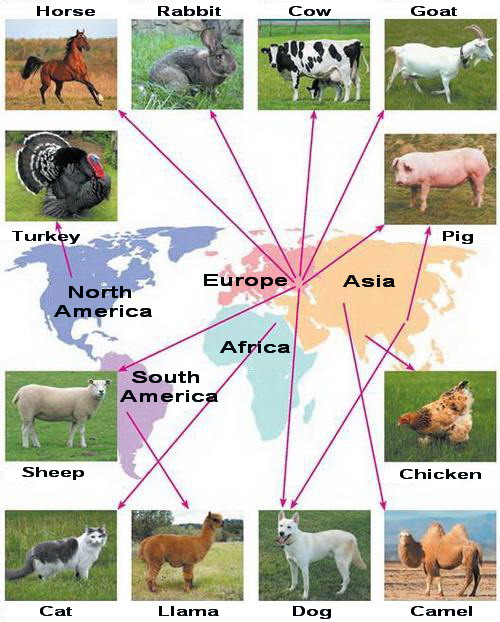
Places of origin of Pets
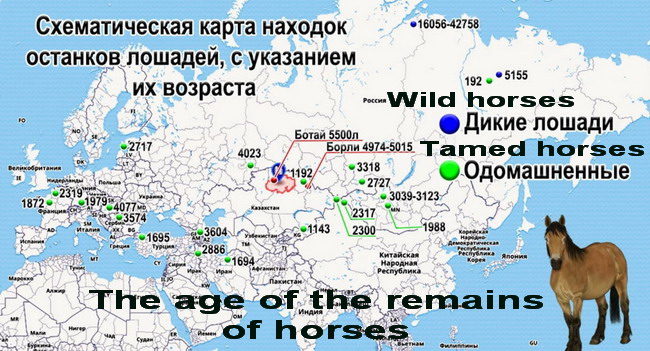
Map of the places where the remains of domestic horses were found with dates of their age. The first horses came from Russia.
| As part of the author's reconstruction, the Flood corresponds to the era of the Late Bronze Age collapse in 1250–1200 BC [10]. The year of Adam's birth, taking into account the date of the Flood and Septuagint information can be determined by simple calculations as 3506 BC. The beginning of Flood according to Septuagint is 2264 years from the creation of the world and falls on 1244 BC, which is a priori true.
The Mono centric paradigm of the origin of people in the Volga region about 5520 years ago is fully confirmed by the PIE theory [1–4], the domestication of horses and other animals in the Caspian region around 4800 BC, the spread of carts and wheels from the Southern Urals to Eurasia from the III Millennium BC, as well as the constant migration of the population from the Volga region, the Urals and the Caucasus. In addition, the expansion of tribes from this region is confirmed by genetic studies of human DNA.
After the Flood or the Late Bronze Age collapse, which was caused by the catastrophic reversal of the planet around the plane of the Ecliptic with the change of geographical and magnetic poles, most of Atlantis was washed into the Ocean by a giant tsunami. However, the pyramids and foundations of Atlantes cities, such as Arkaim, have been preserved in the Urals and the Volga region. Tsunami waves moved over the Earth's surface for many years, destroying the ancient civilizations of the Mediterranean, Egypt and Mesopotamia. Direct descendants of God the Father with their families were preserved in the Ark of Noah, which ended its journey through the Flood waves on Ararat Mount. In Greek mythology, they were called Titans, who formed the Olympian Pantheon of gods.
According to the author's reconstruction of history [5, 8, 11], all the patriarchs of monotheistic religions are Ugrians, Haplogroup N1. Accordingly, the Olympic gods are the people of the Ugrians. They were based not on the Greek Olympus, but on Mount Uludag or the Olympus in Bithynia [11]. In the Egyptian Pantheon of gods, the Ugric was Horus, whose totem was the Falcon. Perhaps, in honor of the name of the god Horus, the Ugric people were called. The Falcon became a totem for the gens of Heraclides–Fabia – Flavia–Russ–Rurikovich [5, 11].
We have shown earlier [7] that the beliefs of the ancient Etruscans, Bulgarians, Romans, Greeks, and Mesopotamians included the worship of gods originating in the Volga region. This refers to the main god Tengri or Tini, the goddesses Ashna – Ana – Uni, Mati Turan – Mother Turan, and other deities, including Romulus –Kuri – Quirin(us). Over time, the names of the gods were distorted in accordance with the dialects of the local inhabitants. In the future, when synchronizing historical Chronicles and information from the Scriptures, we will use the results of the work of Elias Bickerman [12]. At the same time, we will take into account that the dates and names of the rulers of Egypt and Mesopotamia before the Late Bronze Age Collapse – the Flood of the XIII century BC are legendary and cannot be independently confirmed.
The main geopolitical event in the post-cataclysm era was the Trojan War, caused by the confrontation between the surviving colonists and the Balkan City-States with the Atlantes Outpost in the Dardanelles – Troy. At that time, there was an acute problem of the shortage of women for procreation, which aggravated the collapse of States and economies in huge regions.
The Trojan War ended according to astronomical data [9] in 1188 BC and according to Eratosthenes and Ctesias – in 1184 BC. According to the author's reconstruction of history [5–9], the Trojan King Aeneas, an ethnic German from the Don River (Tanais) Haplogroup R1b1, brought out the remnants of troops and residents on ships from the fallen city. First, the ships of Aeneas went to Africa in the Nile Delta, where they easily conquered the weak Egyptian civilization led by the Pharaoh Narmer. In ancient times, the country had a different name, which changed to the word Egypt only in the X century BC during the reign of Pharaoh Uneg, aka King Atys Silvius or Egypt [6]. After the occupation of the country on the Nile, Aeneas and his companions went to their ancestral homeland – Atlantis in the Caspian region. After the Flood, the configuration of the Seas and Oceans changed significantly, so in the interfluve of the Volga and Don, you could get two ways – through the Mediterranean Sea and Black Sea or by Seas or straits from the Red Sea and the Indian Ocean to the Caspian Sea.
Upon arrival in the Caspian region, Aeneas sent the water of the Volga, which was called Ra or Itil, to old Channel, which took half the flow of the main river. The old channel was named Akhtuba. The same name was assigned to the man-made island between the Volga and Akhtuba. The Egyptians called Ahtuba – Life of two lands or Ankh Tawy. Currently, the Volga–Akhtuba river system is the largest and oldest hydraulic structure in the world. The length of the island is about 450 km, and the land area is more than 10 thousand square km. African Egypt has never had such a system. As a result of the Trojan conquests, a gigantic state was formed, located in three parts of the world – in Africa Upper Egypt, and in Europe and Asia – Lower Egypt on the island of Akhtuba. Lower Egypt on the Volga-Ra lasted until 509 BC, when the Kings and Pharaohs were expelled from Rome and Memphis. Since then, the toponymy of Lower Egypt has settled in the Nile Delta [6, 7].
It is not surprising that crocodiles were found in Akhtuba until the XX century and African lotuses still grow!
Note that the traditional localization and Dating of the existence of the Hittite Kingdom and Mitanni [12] is a forgery to prove the antiquity of the Jewish people. In fact, these countries were located far to the North of African Egypt – in the Caspian region and Volga region and operated in the I Millennium AD. The self-name of States were different they referred to themselves as parts of the Great Bulgaria/ Idel. Later we will show that the King Artatama I is identified by the author with Khagan Arbat – the leader of the Huns or Israelites in the IV century.
Let's start synchronizing the Chronicles of Ancient Egypt with real history by linking astronomical phenomena described in artifacts [9]. We are talking about the Solar Eclipse in Ithaca (1178 BC) and the date of the end of the Trojan War in 1188 BC. This point corresponds to the beginning of the Chronicles of Ancient Egypt from the reign of Pharaoh Menes (1219–1172 BC). We understand that 1219 BC refers to the beginning of the reign of Menes/Aeneas over the Trojans. In Egypt the King will get only in 1188–1184 BC the First Pharaoh of the New dynasty is Teti I/Atotis I, who died in 1171 BC. According to the List of Kings of Abydos, the last number of the list is the cartouche number 76 of Pharaoh Seti I. Ramesses II and Merneptah ruled after him. We found a chronological shift in the history of Ancient Egypt by 1780 years [6]. Therefore, the reign of Seti I in 500 end, but not in 1279 BC, and the reigns of Ramesses II and Merneptah fall on 500–566 and 566–586, respectively. The dates of the reign of Ramesses II and Merneptah are precisely confirmed by the Zodiacs of Dendera [6, 9], according to which the construction of the first and second stages of the Temple of Hathor fall on 540 and 568. The period of the reign of the Pharaohs from Menes to Seti I is 1720 years, taking into account the reign of Ramesses II and Merneptah, the period of time increases to 1788 years. The next reference point for synchronizing the Chronicles of the Egyptian Pharaohs is the date of the Solar Eclipse of Takelot I. According to our calculations [9] the Solar Eclipse occurred in the 15th year of the reign on August 8, 891. Traditionalists believe that Takelot I ruled in 905–867 BC, but there were no suitable Solar Eclipses in Egypt at this time. According to the author's reconstruction, after the IX century in Egypt there were no independent Pharaohs, except for the rulers of small Nomes. Egypt under the Fatimid’s became part of the Muslim world.
Thus, our synchronization of the dates of the reign of the Pharaohs from Menes to Takelot I occupies horizon of 2133 years from 1219 BC to 913. The error in synchronizing events does not exceed one or two years and is confirmed by astronomical phenomena. Further, we will show that synchronization will also be justified by numerous real historical facts recorded in the Chronicles of different States. Accordingly, all evidence of the existence of ancient Judah and Israel before our era is the product of the fantasies of religious fanatics. In addition, the name of the country Egypt did not exist before X century BC. Therefore, the binding of ancient Chronicles [12] to events common with Egypt and the Pharaohs before the Late Bronze Age collapse or the Flood of 1250–1200 BC is fictional.
Around 1172 BC in the Volga/Ra and Don/Tanais river basin, more precisely on the island of Akhtuba, the Trojans built the fortress the White Walls, or Alba Longa, or Inebu Hedj. The Kings of the fortress often became the Pharaohs of Ancient Egypt. The Kings of Alba Longa were not always recognized as Pharaohs, and vice versa [6, 7]. For this reason, the chronology, history, and times of the reigns of the monarchs of Ancient Egypt and Alba Longa of the Early and Ancient Kingdom are identical. The era of the construction of the giant pyramids in Giza corresponds to the VIII–VII centuries BC – to the reign of Pharaoh Cheops, aka Procas Silvius, and Pharaoh Chephren, aka Amulius Silvius.
In the middle of the VII century BC there was a revolutionary change of the ruling elite of Egypt and Alba Longa. Pharaohs and Kings is ethnic Germans succumbed power to the Ugrians is children of mixed marriages of Olympic gods and people. From Ares and a virgin priestess, according to Roman mythology, the vestal Rhea (two children), and in Egyptian mythology, the sister of the priest Raddjedet (three children), twins were born [6, 7]. In the Bulgarian Chronicles, we are talking about one infant. Note that information about a similar myth is contained in three independent sources – Egypt, Rome, and Volga Bulgaria. The author established the fact of intertwining the history of these States since the Flood.
| 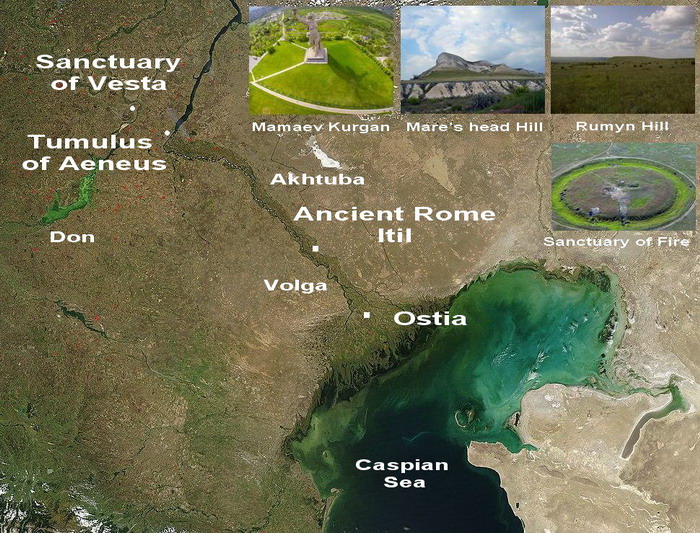
Map of the Caspian region I Millennium BC
| In 753 BC Romulus made the first furrow around the Palatine Hill, founding the city of Rome. Taking into account the chronological shift of 1780 years, Memphis was founded in the same year. In fact, we are talking about a city on two banks of the river Akhtuba – Rome on the mainland and Memphis on the island part. The Chronicles of the Bulgars called Rome/Memphis is Ulak Urum (Rum) or Itil. Both cities were connected by bridges, where active trade was conducted. In 64 after a disastrous Fire in Ancient Rome, Nero moved the capital to the Etruscan city Veii on the banks of the river Cremera, called later the Tiber [7].
Romulus became the first King of Rome. In Egypt he was called Pharaoh Userkaf, and his brothers were considered Sahura and Kakai. Only in the Roman Chronicles brother Remus died, but in Egyptian history all the brothers were Pharaohs, and the sources of Bulgar keep silent about the brothers of Genghis (Son of the Wolf). Direct descendants of Romulus were ethnic Ugrians, Haplogroup N1. Therefore, since the VIII century BC in the elites of Rome and Egypt, there were contradictions and a struggle for Supreme power between two ethnic groups – the Ugric and Germanic.
In traditional Egyptian history, the ethnic change of elites corresponds to the V and VI dynasties of the Ancient Kingdom. In the future, only part of the Kings of Rome was recognized as Pharaohs of Egypt and vice versa, so the number of Kings and Pharaohs do not correspond to each other. However, in 509 BC the elite of Rome expelled their last King Lucius Tarquinius Superbus, and the Republican period began. At the same time, the Romans drove out the Pharaohs and the Egyptian elite, who settled in Upper Egypt on the Nile, where the toponymy of Lower Egypt on the Volga/Ra eventually moved. In Egypt the Lucius Tarquinius was called Pharaoh Meryre or Pepi I. In African sources, it is said that the Pharaoh lost influence among the nobles and made several unsuccessful military expeditions. We are talking about falling into vassalage from Ancient Persia and unsuccessful attempts of Lucius/Meryre regain power over Lower Egypt and Ancient Rome in the Volga region. As a result, the VI Ugric dynasty of the Ancient Kingdom lost world domination, which passed to Ancient Persia, led by the Achaemenid dynasty. The Persian Kings Achaemenes were Germanic origin from the Volga region and may have been descendants of the first Pharaohs Menes of Egypt [7].
Then in the history of Ancient Egypt, the First Transition period began from the VII to XI dynasties, with the period of the XI–XII dynasties belonging to the Middle Kingdom. When synchronizing the Chronicles, it turns out that the First Transition period corresponds to the rule of the Egyptian satraps of Ancient Persia, about whom almost nothing is known.
The Middle Kingdom absolutely falls on the era of Ptolemaic rule in Egypt [6, 7]. The last ruler of the Middle Kingdom was the woman Pharaoh Neferusobek, also known as Cleopatra Selene [6, 7].
The Middle Kingdom was replaced by the era of the Hyksos – "Shepherd kings" or "Rulers of foreign lands". We have shown that this period of the Hyksos certainly corresponds to the Roman occupation of Egypt [6, 7]. The entry of Egypt into the Roman Empire was accompanied by the appearance of a new state entity in the desert area of Palestine is the province Iudaea. The governors of the province were representatives of the Roman nobility – Herodian dynasty, is descendants of Antipater – the Roman Procurator. The province was named after its ruler Herod. A few centuries later, the Jews in their books changed the Roman name Iudaea to Judea, playing with the letters by replacing the original with a name convenient for their imaginations. In doing so, they created a verbal bridge between the name of the Rome province in 6 AD and the fictional Kingdom of Judah and the Great Israel in Palestine in BC.
Chief archaeologist of Israel Ze'ev Herzog in recent years has repeatedly stated that Israel was dug up length and breadth, but no one has managed to find artifacts older than I century, which fully confirms the fact of the development of the desert area of Palestine only since the creation of the Roman province Iudaea in 6 AD.
The next chronological period of Ancient Egypt is called the New Kingdom. According to our reconstruction [6, 7], the New Kingdom was founded by the Roman Emperors of Egyptian origin the Gordians, who were descended from the Roman noble family gens Gracchi ethnic Germans. The details of the biographies and periods of the reign of the Pharaohs and Gordians correspond exactly to each other. Representatives of the XVIII dynasty revived the unprecedented power of Egypt. The woman Pharaoh Hatshepsut carried out an expedition to Punt/Pont, that is visited the interfluve of the Don and Volga visited its ancestral home – the Akhtuba Island and Ancient Rome/Itil at the beginning of the IV century. Then the Pharaoh Thutmose III, called the Napoleon of antiquity, conquered Mesopotamia and the country Mitanni that is the Caspian region and Volga region, in a series of military campaigns. Ancient Rome/Itil fell under the blows of Egyptian chariots in 324 AD.
The Pharaohs of the nineteenth dynasty lost control of the conquests of Thutmose III and lost the lands of Itil. The Abydos list ends with the Pharaoh Seti I, who died in 500. The reign of Ramesses II and Merneptah was accompanied by an unprecedented successful of Egypt and the construction of new temples and tombs. The Zodiacs of Dendera date the years of construction of the first and second stages of the Hathor Temple to 540 and 568, and the Merneptah Stele with the mention of the people of Israel is dated by the author to the end of the VI century [6–9].
In the first half of the seventh century Ramses III sent an expedition to Punt/Pont, which reached the Ural copies and brought a huge amount of copper. Then the XX dynasty lost control of Egypt. The power of the Pharaohs was preserved only in small Nomes. During the reign of the XXII dynasty, the Title Pharaoh of Lower and Upper Egypt was worn as a tribute to tradition, but not as regalia of the real ruler. Since the eighth century, Egypt has been dominated by the Umayyad’s, Abbasid’s, and Fatimid’s. Under the Fatimid’s Egypt finally became a Muslim territory in which the beliefs of the ancient Egyptians could not be legal. Therefore soon after the reign of the minor Governor of the Pharaoh Takelot III of the XXIII dynasty, all the other dynasties from XXIV to XXXI of Ancient Egypt of the Later period are figments of the imagination of Egyptologists.
Traditional history describes in detail the chronology of the Hittite Kingdom and Mitanni [12], referring to their existence before 1200 BC. We believe that information about these States is part of the forgery of ancient history in favor of the fantasies of religious fanatics. We have already said that the names Hittites and Mitanni refer to the inhabitants of great Bulgaria from the Caucasus, Caspian and Volga regions. The rulers of Mitanni are actually Khagans of the Bulgarians, Huns, and other nomads. The identification of the names of the Khagans and the Mitanni Kings is not within the scope of this work. In Egypt the state Mitanni was called Naharin country. According to the author's reconstruction [8], Patriarch Nahor is identified with one of the gens Fabians who lived in the Volga region in Ancient Rome/Itil in BC era.
The chronology of Ancient Rome does not require special synchronization with the author's reconstruction, since it is basic, but it is necessary to clarify the geographical location of Alba Longa and Ancient Rome in different historical epochs. Alba Longa and Ancient Rome were originally located in the Volga region, on the river Akhtuba/White. Local residents self-name is Altin-bash, Altynany (Golden, Latin). Rome's expansion was initially directed to the Caucasus and the Volga region, then the Mediterranean and Mesopotamia. Then start the capture of Egypt, the Apennines, the Balkans, and Europe [6, 7]. In 64 there was a Great Fire in Rome, in which most of the wooden city burned down. After this, the Emperor Nero moved the capital to the Apennines on the site of the Etruscan Veii. The idea was supported by the Emperor Titus Vespasian Flavius, who built the Coliseum or Flavian Amphitheatre. Over time the toponyms of Ancient Rome in the Volga region were transferred to Italy and the city on the Volga became known as Itil (derived from name Pharaoh Iti). However, Rome in Italy could not become a densely populated metropolis, when in the middle of the V century it was destroyed by Barbarians and was in a deplorable state until the XIII century.
Let us explain the essence of the supposedly amazing demands of the Barbarians who regularly attacked Italian Rome and Constantinople. In 395 the Visigoths led by Alaric besieged Constantinople, but they had to retreat. In fact, the Visigoths were not enemies of the Roman dominions, but were confederates and part of the Roman army. In our works [5, 8] we have shown that all the so–called Barbarian Ostrogoths, Visigoths and Huns were part of the Roman/Israeli peoples living in the Caucasus, the Don and Volga region and the Caspian region. In honor of Constantine the Great, aka Kubar, Ya’qub, Jacob, Israel, they called themselves Kubanites and Bulgarians. After 64 some of the elite of Ancient Rome moved to Rome/Veii, but most of the population remained in the Volga region.
After the capture of Rome/Itil Egyptians led by Thutmose III, formed a wave of migration of Romans–Israelites–Kubanites from East to West. The Migration period of peoples was not initially hostile to the Roman colonists who had settled earlier in the West.
The first Huns invasion led by the Khagan Arbat just consisted of such refugees, numbering more than 600 thousand people. Some of the migrants were military units of vandals and Visigoths, often acting independently, but were federates of the Roman army.
Arbat, who became Emperor Theodosius the Great of the Eastern Roman Empire, settled in Constantinople. Some of the refugees stayed with him in New Rome, but many tribes and peoples settled in the Balkans and Europe. Alaric's Visigoths were not accepted in Constantinople, as ethnic Germanic Latin moved further into Western Europe and Rome in the Apennines.
Alaric's army besieged Rome several times. His ally was the vandal Stilicho, who was at that time the de facto Emperor of the Western Roman Empire. Stilicho was executed in 408. Alaric converted to Christianity. All this confusion of facts defies the logic of traditional historians. In fact, Alaric and Stilicho were part of the Exodus, which was led by the Khagan Arbat, aka the Leader Moses and Emperor Theodosius the Great. Visigoths, Ostrogoths, Vandals, and Huns were Exodus refugees and Roman citizens from the Volga region, the Caucasus, and the Caspian region. They sought equal rights with citizens of the Western Roman Empire.
In 408 Alaric besieged Rome for the first time and demanded financial compensation from the local inhabitants. He "freed" all the Roman slaves in the number of 40 thousand people. If there were 1 million people living in Rome at that time, why were there so few slaves? In fact, in Rome on the Apennines lived no more than 100 thousand people along with slaves. A million people lived in Ancient Rome/Itil on Akhtuba, from them in 370th of the 600 thousand people migrated to the West. Finally in 410 Alaric captured Rome, but he did not rob Churches, Cathedrals or Monasteries, which is not surprising, since he was a devout Israelite and Christian.
In 455 as a result of political intrigues in Rome, the Empress Licinia Eudoxia called on the Vandals led by Geiseric to depose her husband Flavius Petronius Maximus. As a result of the plot, Maximus was killed by the Romans, and in June 455 the Vandals captured and sacked the city. However, there were no reports of civilian killings. The Vandals took to Carthage numerous riches and the family of Eudoxia. After that, Rome in the Apennines lost its power and was in decline. We believe that both episodes of the capture of Rome by the Barbarians were part of the Exodus wars of the Israelites–Kubanites–Romans. The refugees demanded from the colonists of material and political assistance, but to use military force in case of failure thereof. Waves of migration of Vandals, Goths and Huns in the IV–V centuries were two waves of Exodus, as it is said in the Old Testament under the leadership of the Leader Moses/Dux Moesiae and 40 years later Joshua they are the Khagans Arbat and Attila.
The next element of the ancient chronology that needs clarification is the history of Bithynia and the dating of the reign of its Kings. In 64 Bithynia became a province of the Roman Empire, and in the IV century the territory became an administrative part of New Rome or Byzantium. According to the author's reconstruction of history [6, 7], the Kings of Bithynia, who founded Prusa/Bursa city at the foot of the Lesser Olympus/Mount Uludag, were Constantius Chlorus and Constantine the Great, they are respectively Prusias I and Prusias II. In [12] the reign of Kings Prusias I and Prusias II is dated to 230–182 BC and 182–149 BC. We believe that the actual rule was in 257–305 and 305–337 respectively. The Prusa city from the III century became the Throne of Russ, which passed by inheritance between the Ugric Kings, up to the time of Rurik and the Lakapenus [11]. After Constantine the Great/Prusias II the rulers of Bithynia and Prusa are the Khagans Balamber, Arbat and Urus Ruzha Burgas, who passed Prusa to his nephew Attila. Traditional history dated the reign of Prusias I based on references to Hannibal, who allegedly participated in the war on the side of Bithynia and died of poison in 183 BC. We believe this interpretation of events is erroneous. In fact, Prusias I, aka Constantius Chlorus, had a son Flavius Hannibalianus the Elder from his wife Theodora. Hannibal was the younger half-brother of Constantine the Great, whose mother was concubine Saint Helena. Hannibal the Elder is dead and his biography is lost. Also known is the second Hannibal the Younger (Flavius Hannibalianus), nephew of Constantine the Great and son of Flavius Dalmatius. Constantine the Great, also known as Prusias II, granted the Title King of Pontus to Hannibal the Younger in 335 making him his heir. However, in 337 the heir to the throne was killed in Constantinople. It is obvious that both Hannibal, as the closest relatives of Prusias I and Prusias II, were included in the Chronicles of the reign of the Kings of Bithynia. The Carthage has nothing to do with it.
Let's move on to synchronizing the historical Chronicles of ancient States with the Scriptural of adherents of monotheistic religions. Modern man according to the Kurgan hypothesis [1–4] occurred in the XXXVI century BC. Author's research dates the birth of Adam to 3506 BC [5, 8].
The World Flood or the Late Bronze Age collapse occurred in the period 1250–1200 BC according to the author's calculations, the Flood began in 1244 BC [5, 8] and lasted for years. We are talking about a catastrophic turn of the planet around the plane of the Ecliptic with the change of geographical and magnetic poles, including long-term interference waves of the tsunami in the World Ocean.
When following the Septuagint Dating, it turns out that Abraham should have been born in 180 BC, but according to the author [5, 8] it happened in 7/9 only. Abraham was a real historical figure the Ugric Khagan Tash Bash/Artan [13], aka the Emperor Titus Vespasian Flavius. There is a chronological gap of 190 years, but we believe that the error is caused by inaccuracies in the family tree of the Patriarchs, who were ethnic Ugrians originally from the Volga region, and not Semites from Palestine.
Isaac was the son of Tash Bash with the Ugric name Agha Ruzha (Red Aga), aka Avitakhol [13], whom we identify with the Emperor Constantius Chlorus [5,8], who died in 305. Tash Bash and Agha Ruzha built the first Christian Church in Mecca the Kaaba about 150. Agha Ruzha killed Tash Bash in a duel on the Temple Mount in 163 in Palestine [5, 8].
Jacob is identified by us with Constantine the Great, aka Barys / Kubar [13], Jacob, Ya’qub, and Israel. The followers of Constantine began to call themselves Kubanites or Israelites after the battle of the Laba River in the North Caucasus with the pagans and Praetorians of Maxentius in 312 [5]. Constantine received the religious name Israel during the battle with pagans in the waters of Laba, and the symbol Labarum also appeared in honor of this event. According to Theophanes [14], Constantine the Great held an Ecumenical Council in Nicaea and accepted the Creed in 316 (in reality in 325). The chronological distance from the birth of Abraham (Tash Bash) to the death of Jacob (Kubar) is 330 years. Contemporaries of Isaac and Jacob were the woman Pharaoh Hatshepsut and Pharaoh Thutmose III.
In 342 the Khagan Arbat/Alp Abay was born. He lived on the Volga in the possession of the Pharaoh Thutmose III, who in 324 captured the Mitanni or Naharin country [5, 8], that is the island of Akhtuba with Ancient Rome/Itil and the surrounding land. The island of Akhtuba was called Lower Egypt in the distant past. Arbat led the first wave of Exodus of Roman–Israelites–K(Q)ubanites from the Volga region and the North Caucasus, known to historians as the Hun invasion. Arbat transferred 600,000 refugees across the Black Sea ice from the Kuban – Bosporan Kingdom to the Crimea along the Tuzla spit in January 379. For this feat, he received the Roman military title Dux Moesiae or Leader of the Moesia on January 19, 379. At the same time he was elected Emperor of the Eastern Roman Empire under the throne name Theodosius the Great.
In the Crimea on the Mountain Rock of Ai–Petri the Khagan Arbat has received Tables of Stone. The toponymy of the mountains and passes of Crimea contains the words Zion (Sion) and Sinai. Lake Marah is also located there as lake Sivash. In the Crimea, after the campaign of Arbat, there were names – the Arabat spit (along the spit, the refugees got to the mainland) and Feodosia city.
At the end of 380 Arbat/Theodosius entered New Rome, where he carried out a number of religious reforms. The Emperor established Christianity as the state religion, introduced an annual Passover celebration to commemorate the Exodus of the Israelites from captivity in April 378 and the receipt of the Tablets of Stone in April 379, and banned the Olympic Games. Instead, Arbat founded the annual chariot races in honor of the departure of refugees from the pursuit of Egyptian chariots across the Kuban and the ice of the Black Sea. Then, at the Hippodrome in Constantinople Theodosius installed a copper Serpent Column in honor of getting rid of asps during the Exodus, and also erected an Obelisk of Pharaoh Thutmose III (his contemporary) in honor of establishing peace and friendship with Egypt. The obelisk was made in 355 then moved to the city's embankment to take its place at the Hippodrome 35 years later. The Column and Obelisk are sculptural witnesses of the Exodus. In 381 Theodosius held the Council of Constantinople, which approved the Old Testament Creed and the rules for determining the date of the celebration of Easter. Jesus Christ was not yet born, and Christianity existed as theoretical religion. In the Egyptian Chronicles Khagan Arbat came under the name of the Mitanni King Artatama I.
| 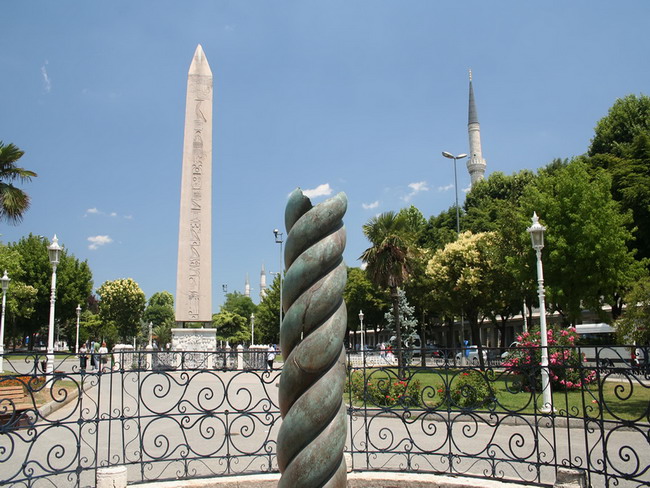
Artifacts of the Leader of Moses - Khagan Arbat - Emperor Theodosius the Great at the Hippodrome of Constantinople - the Obelisk of Pharaoh Thutmose III and the Serpent Column.
| 40 years after the death of the Arbat/Theodosius, his grandson Attila entered the world stage [5, 8]. The Khagan Attila led the second wave of Exodus and the Hun invasion of Europe. The author identifies Attila/Aetcel with Flavius Aetius, and Emperor Theodosius II, and Joshua [5, 8, 9]. Note that for the ancient Bulgars, Kubanites and Israelites the Biblical Jordan was the Danube River. No wonder the Khagan Arbat called the land between the Danube and the Dnieper Atalyk or Tsar's lot – volume III, p. 90 [14]. Acts of Attila/Joshua was accompanied by a series of Solar Eclipses [9].
According to the Septuagint tradition, the Exodus occurred in the 3840 year from Adam, which in our case means is 3506+3840=334. In the author's reconstruction, the Exodus began in 378, an error of 44 years, which is not bad for the horizon of 4 millennia. The invasion of Canaan by Joshua/Attila began 40 years after the death of the Leader Moses/Dux Moesiae – the Emperor Theodosius the Great. Further comparison of the author's reconstruction with the Biblical chronology according to the traditions of the Jews and Septuagint gives big errors and is pointless.
The period of Judges in the author's reconstruction falls on the time after the collapse of the Empire of Attila in 455 until the end of the reign of Judge Jurgan Teles. Jurgan is the Emperor Phokas (602–610), he is also King Saul (for Muslims is King Talut) that is the period of existence of the Israelites – Kubanites without the Supreme Khagans lasted only 150, not 300 years [5, 8].
In 610 the Emperor Flavius Heraclius I Augustus ascended to the throne of the Empire. We identify him with the Khagan Kubrat (575–660) and King David [5, 8]. Kubrat was the nephew of Jurgan Teles. Chronicles directly say that the Khagan Kubrat was born in the Purple Hall of the Palace in New Rome, like all Emperors, and bore the Title Caesar, i.e. Emperor. Heraclius/Kubrat created a huge religious state the Great Israel or Great Bulgaria. For the numerous tribes and peoples of Byzantium, the Middle East, the Central Asia, the Caucasus, and the Volga region, the Roman Empire, with its capital Constantinople, was identified with a Power to which all were subject to varying degrees. The other capital of Great Bulgaria was Phanagoria, an ancient city of the Bosporan Kingdom. The Israelites called Kubrat is Father or Dad, hence his name David. The name DAD is inscribed on mosaics and frescoes of the Chora Church (XIV century) in New Rome/Constantinople.
Heraclius/Kubrat participated in many wars in Europe, the Middle East, the Caucasus, and Mesopotamia. For many years the Byzantine-Sasanian War (602–628) lasted, during which the Sassanid captured Jerusalem/El Quds in 614 and in 616 conquered Egypt. The Persians in El Quds destroyed the first Christian Temple built by Saint Helen and Saint Constantine on the Temple Mount. As a result of the Persian conquests, part of the population of Palestine was moved to Iran, where the Babylonian captivity of the Jews began. Before these events of the seventh century, no Babylonian captivity and the expulsion of the Jews from the Land of Israel could have taken place physically. Under the pressure of fanatics, historians imposed the Sassanid conquests on the acts of the Babylonian Empire, which, in our opinion, never existed in reality.
The religious reforms and military campaigns of Kubrat had a great influence on the formation of new religions of monotheism. Eastern fundamentalists, who considered Kubrat a Prophet, integrated the biography of the Khagan with the personality of the Prophet Muhammad and created Islam. Due to the Persian war, the Muslim community of Mecca moved to Medina in 622, which gave rise to the Islamic calendar. The Prophet Muhammad, who wrote the Quran in 1130–1152, lived in 1090–1152 only [5, 8].
The presence of Palestinians in Persian captivity gave rise to the formation of a separate religious movement – Judaism, the Holy book of which was the Talmud. The Talmud was an independent religious book that contained information about the Patriarchs of humanity of Bulgarian origin and the deeds of the Israelites of the Exodus periods (IV–V centuries) and Judges (V–VII centuries). Therefore, there is no place for Jesus Christ, who has not yet been born. The formation of the Talmud ended by the X century, it included the acts of Kings Saul, David and Solomon (VII–VIII centuries). In parallel to this process, the books of the Old Testament and the Torah were edited and supplemented.
King Solomon is identified with the Khagan Sulabi, aka the Emperor Justinian II Rhinotmetus, later the Caliph Suleiman in Palestine [5, 8]. The Prophet was not a son, but a grandson of King David/Kubrat. In the early seventh century, Kubrat ordered the restoration of the Christian Church on the Temple Mount after the victory over the Persians in 629. Justinian II Rhinotmetus/Solomon managed to finish the Church in 711. Since then, the Temple of Solomon, also known as the Qubbat As–Sakhrah Mosque, has stood on the Temple Mount in Jerusalem. The name reflects the name of the Heavenly father Kubrat and the name of the Prophet Kubrat/King David. Therefore, the Temple of Solomon was never destroyed and the Western Wall can’t have a religious meaning as a reminder of the lost Jewish Temple. No wonder the first mention of the Western Wall appeared only in the XI century.
| 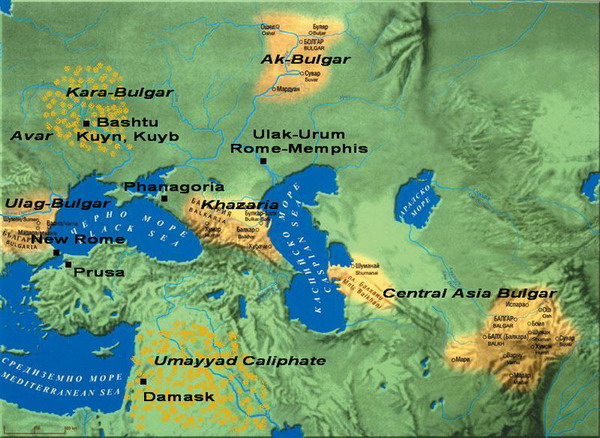
Map of Great Israel - Great Bulgaria of the VII century.
| One of the trends of Judaism is Karaite Judaism appeared in the VIII century. The Karaites believe that their religion originated from the time of the Second Temple, i.e. according to the author's reconstruction – after 711. Karaism flourished in the VIII–XII centuries. The Karaites are not Semites, but Turks – Israelites of the Bulgarian tribes who have remained in the Crimea since the Exodus in 379 under the leadership of the Khagan Arbat/Leader Moses. Part of the Karaites profess Judaism, and a smaller part of Christianity. Karaites are living proof of the author's reconstruction of history, which adhere to two archaic trends of monotheism of the Israelites of the end of the IV century.
For the first time in the earth's history, the Jewish state appeared in the IX century on the basis of the Khazar Khaganate. In 740 one of the Beks/Prince Bulan of the Khazar converted to Judaism. His descendants at the beginning of the IX century received the real reins of government of the country and made Judaism the state religion. In the IX–X centuries there was an active rewriting and editing of the Scriptural of Christians and Jews the Old Testament, Torah and Talmud. Muslims in Damascus and elsewhere attempted to write their own Scriptural, so the first Ayah and Surah appeared, which then became part of the Quran.
In the 962 of the Christian Era in the family of a direct descendant of the Ugric Kings and Khagans Abraham/Tash Bash, Isaac/Agha Ruzha, Jacob/Kubar, the Leader Moses/Arbat, Joshua/Attila, David/Kubrat and Solomon/Sulabi from the gens of Russ–Flavians is Prince Vladimir and Princess Anna Macedonian was born the Blessed Virgin Mary/Maria [5, 8].
At the junction of 979/980 Mary was born a Son of God – Jesus Christ with the Russ name Zlatoust. On March 18, 1010 on Mount Beikoz, also known as the Head of Adam or the Bed of Hercules, the Lord was crucified by Orthodox Christians. The execution was accompanied by an unusual Solar Eclipse [8, 9], when from the middle of the day Darkness enveloped the Mediterranean, and there was an Eclipse of the 94th Saros at sunset [15, 16]. The Savior was buried next to Golgotha in the cave of Yoros in the true Empty Tomb of the Lord. On the third day according to the Scriptures, Jesus Christ rose on the day of the vernal equinox on March 20, 1010. Then the Savior left Byzantium via Damascus. The events of 1010 ended the times of the Old Testament and theoretical Christianity and opened the era of the New Testament. This was the year 2254 from the Flood and 4519 from Adam. After this he performed many amazing divine acts, and his earthly life ended in China, in the province of Shandong, the Qufu city in May or July 1054 [8, 9]. Before the Savior's death, there was a double celestial phenomenon – the Solar Eclipse on May 10, 1054 of the 103th Saros [15, 16] and an explosion of Supernova (M1) in the constellation of Taurus.
| 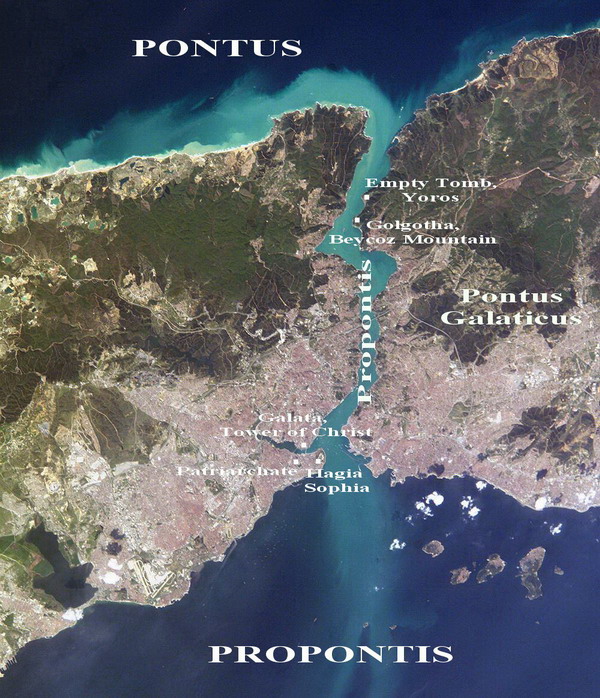
Biblical places of the New Testament from Space, XI century.
| Biblical events end with the acts of the Prophet Muhammad (1090–1152), who wrote the Quran, in 1130–1152 [5, 8]. The Prophet was from the family of Quraysh, which we identify with Urus Ugyr Aydar or the Great Horseman Igor, the father of Rurik. Muhammad was one of the Prophets and Patriarchs of Russ –Flavians is ethnic Ugric, Haplogroup N1. The Prophet Muhammad became an integration of two personalities – Khagan Kubrat of the VII century and Muhammad of the XII century [5, 8]. The date of the Prophet's death is determined by the day of death of his son Ibrahim, when there was Solar Eclipse. According to the author's reconstruction, this sad event occurred on February 7, 1152 (28 Shawwal 546 AH), the Solar Eclipse of the 107th Saros [15, 16].
To correctly synchronize the historical Chronicles of Ancient Egypt, Ancient and New Rome, and the Holy Scriptures, the author used data from 11 celestial phenomena [9], as well as information about hundreds of historical figures whose deeds are reflected in many independent sources. Data on the Prophets, Patriarchs and identification of historical figures with them are based on the family trees of the Prophet Muhammad and the Bulgarians Kings.
The results of our research will be summarized in the Table No.1 synchronization of historical and religious Chronicles, celestial phenomena according to [15, 16].
| 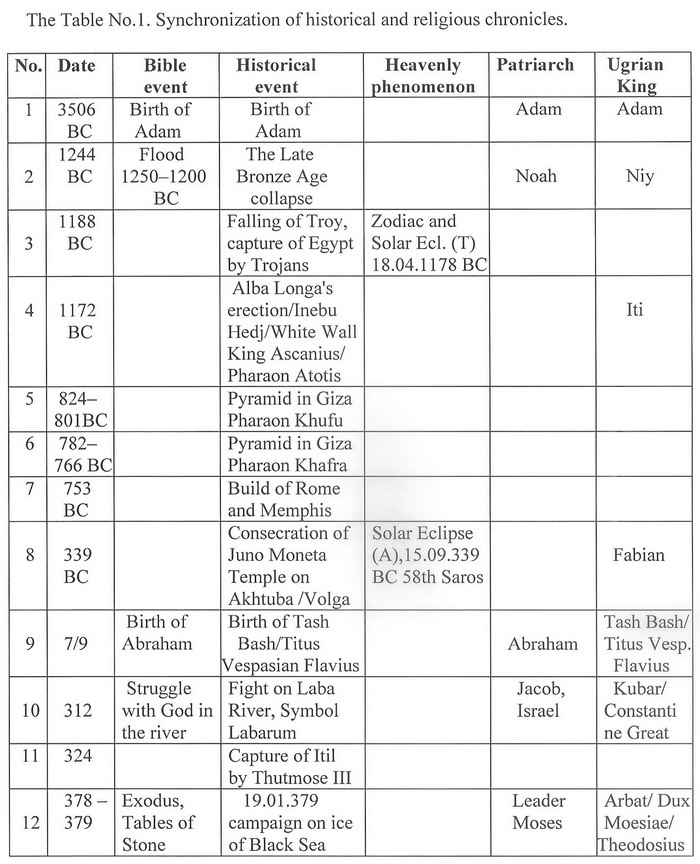
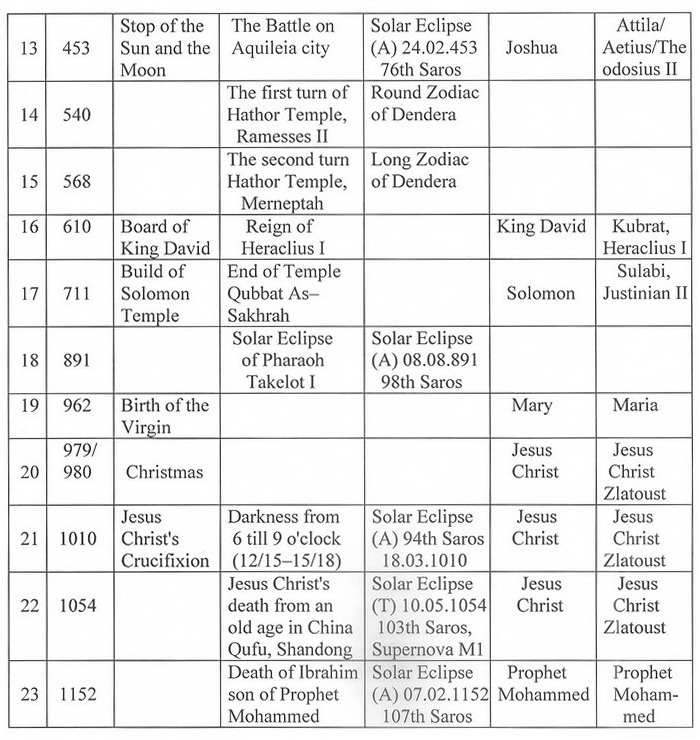
| Conclusions of our research: the Author's paradigm of the short history and chronology of religions [5–9] is fully confirmed by synchronizing the Biblical Chronicles and characters with the historical annals and figures of Ancient Egypt, Ancient and New Rome, Volga Bulgaria and Asian countries. Chronicle synchronization is certified by an additional binding of events through eleven celestial phenomena in the form of Solar Eclipses and Zodiacs, as well as a Supernova M1. Pr. Dr. Valeriy Viktorovich Kubarev, 20.04–25.05.2020. Bibliography: 1. Gimbutas, M. (1964) Bronze Age Cultures in Central and Eastern Europe. Mouton.
2. Gimbutas, M. (1977) The first wave of Eurasian steppe pastoralists into Copper Age Europe. J. of Indo–European Studies, vol. 5.
3. Gimbutas, M. (1974) The God and Goddesses of Old Europe. 7000–3500 B. C.
4. Gimbutas, M. (1980) The Kurgan wave № 2 (c. 3400–3200 B. C.) into Europe and the following transformation of culture. J. of Indo–European Studies, vol. 8.
5. Kubarev V.V., Vedas of Russ, IP MEDIA, M., 2009. ISBN 9781-93252567-0. Link: http://www.kubarev.ru/en/content/251.htm
6. Kubarev V.V., Short Chronology of Ancient Egypt, EESA, #6 (46) 2019, Part. 4, pp. 30–58.
7. Kubarev V.V., Localization of Ancient Rome, EESA, #7 (47) 2019, Part. 4, pp. 28–59.
8. Kubarev V.V., Chronology of monotheistic religions, EESA #8 (48) 2019, Part. 6, pp. 31–67.
9. Kubarev V.V., Astronomical dating of Biblical events, EESA #3 (55) 2020, Part. 2, pp. 24–35: https://euroasia-science.ru/wp-content/uploads/2020/04/Euroasia__372_6_march_2020.pdf ; Kubarev V.V., Astronomical dating of Biblical events, EESA #3 (55) 2020, Part. 2, pp. 24–35: https://eesa-journal.com/wp-content/uploads/EESA_3_55_march_2020_part_2.pdf
10. M. Liverani, «The collapse of the Near Eastern regional system at the end of the Bronze Age: the case of Syria», in Centre and Periphery in the Ancient World, M. Rowlands, M.T. Larsen, K. Kristiansen, eds. (Cambridge University Press) 1987.
11. Kubarev V.V., Origin of the gens Rurik, East European Scientific Journal (Warsaw, Poland), #10 (50), 2019 part 9. pp. 9–39. Link:
https://eesa-journal.com/wp-content/uploads/EESA_1050_oct_2019_part_9.pdf
12. E.J. Bickerman, Chronology of the Ancient World, London, 1969;
Элиас Бикерман, Хронология древнего мира, Перевод с английского И. М. Стеблин-Каменского, Ответственный редактор М. А. Дандамаев, М."Наука", 1975.
13. Бахши Иман, Джагфар Тарыхи (Летописи Джагфара) Гази–Барадж Тарыхи (Летопись Гази–Бараджа), I – III том. Бахши Иман. Джагфар Тарихы. Свод булгарских летописей 1680 г. / Изд. подготовлено Ф. Г.-Х. Нурутдиновым. Оренбург: Редакция Вестника Болгария, 1993.
14. Chronicle of Theophanes.
15. Fred Espenak, NASA/Goddard Space Flight Center.
16. Catalogue of solar eclipses. Links:
http://www.secl.ru/eclipse_catalog.html
http://astro.uni-altai.ru/HC/eclipses/solar_eclipses.html | Full text of article in format the Word:
18724.docx |
|
